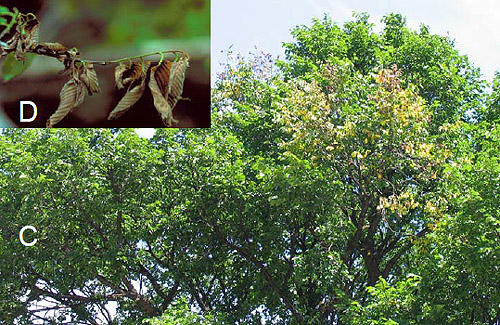Dutch Elm Disease Fungi
 (Ophiostoma spp.)
(Ophiostoma spp.)
Common Names: Ophiostoma, DED
History
First found in North America in Ohio prior to 1930. DED is thought to have been introduced from diseased elm logs from Europe. It has since spread throughout almost the entire North American range of Elms. The disease was first found in Manitoba in 1975.
Physical Description
DED is caused by a fungus, and spread by Elm Bark Beetles and root grafting between Elm trees. Host trees include all the elms native to North America and Europe such as American Elm.
Symptoms
Infected trees show symptoms ranging from curling, wilting and yellowing of leaves on one or more branches, to a rapid death of the entire tree. Frequently, by the time first symptoms are noted, the fungus has already done lethal damage.
Threat
Once the fungus is established within a tree, it spreads rapidly in water conducting vessels of the roots, trunk and branches. The tree forms gums within these vessels in response to the fungus. This blocks water movement in the tree and causes it to wilt and eventually die.
Distribution
DED is found throughout North America and is a major problem in Manitoba. You can help to limit spread by ensuring all dead Elm trees are cut down and properly disposed of, not using or transporting Elm firewood, and avoid pruning your elm trees between April 1st and July 31st .
For suspected DED trees within Winnipeg call (204) 986-7623, for all other areas call the Provincial Tree Line (204) 945-7866.
How does DED spread?
 DED is spread both by specialized Bark Beetles and through root systems. The main species of beetles responsible for carrying the fungus are the American Elm Bark Beetle (Hylurgopinus rufipes) and the introduced smaller European Beetle (Scolytusmultistriatus).
DED is spread both by specialized Bark Beetles and through root systems. The main species of beetles responsible for carrying the fungus are the American Elm Bark Beetle (Hylurgopinus rufipes) and the introduced smaller European Beetle (Scolytusmultistriatus).
[A] Close up of the American Elm Bark Beetle. [B] Close up of the smaller European Elm Bark Beetle. Photos: J.R. Baker & S.B. Bambara, North Carolina State University, Bugwood.org
These beetles, 2-3 mm (1/8 to ¼") long, breed in stressed or recently killed trees. They lay eggs under the bark that hatch into larvae. Spores of the DED fungus are carried on the bodies of beetles and widespread from tree to tree.
Root grafting occurs when trees in close growing proximity may have roots that contact and join. The graft unites the root systems, allowing for the sharing of water, nutrients and, unfortunately, the DED fungus between trees.

[C] A branch infected with DED [D] Closeup of wilt.
Photos: [C] J. O'Brien,USDA Forest Service, Bugwood.org [D] Minnesota Departmentof Natural Resources Archive, Bugwood.com
For more information please see the Manitoba Forestry Branch website or visit Trees Winnipeg: Coalition to save the Elms to see how you can help.
Â
Back to Terrestrial Invasive Species List
Â
© Copyright 2004-2025 - CMS Made Simple
This site is powered by CMS Made Simple version 1.4.1


